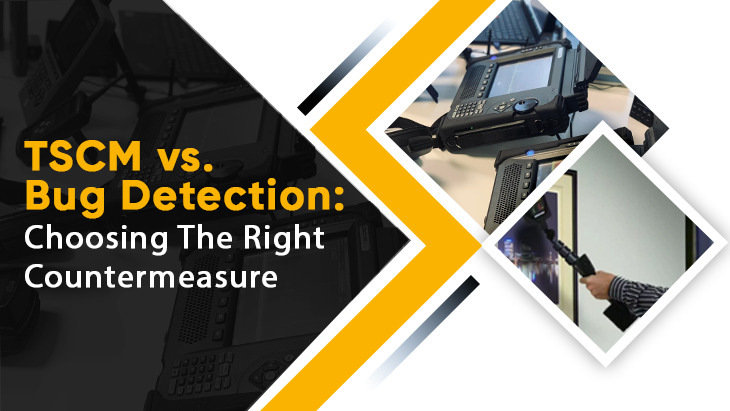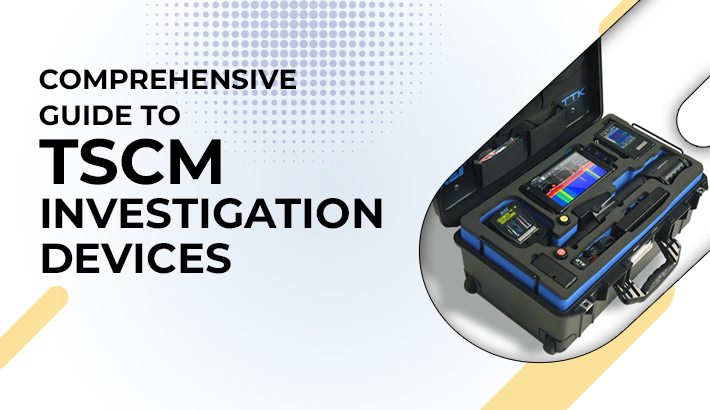In an era where privacy is at risk of being compromised even more by surveillance in its various advanced forms, people and organizations need to learn from this. Threats include hidden cameras, listening devices, and even software ‘bugs’. To counter these threats, two primary methodologies are employed: TSCM (Technical Surveillance Countermeasures) and Bug Sweeping Services. They both work as anti-spying measures but in different ways that they each possess their features and uses. It is essential to note these differences because they help in selecting an appropriate countermeasure required for your needs.
Understanding TSCM
Technical Surveillance Countermeasures (TSCM) refers to a set of techniques and procedures designed to detect, analyze, and neutralize surveillance devices and activities. TSCM encompasses a wide array of counter-surveillance measures aimed at identifying and mitigating threats from various forms of technical surveillance. These measures include:
- Physical Searches: Thorough inspections of physical spaces for hidden devices like microphones, cameras, or transmitters. This might involve dismantling fixtures or scanning areas with specialized equipment.
- Electronic Sweeps: The use of sophisticated electronic equipment to detect and analyze signals emitted by surveillance devices. This can involve spectrum analyzers, RF detectors, and non-linear junction detectors.
- Acoustic Tests: Methods to detect the presence of eavesdropping devices by analyzing sound waves and vibrations. This includes detecting anomalies in ambient noise or identifying hidden microphones through sound analysis.
- Thermal Imaging: Using infrared cameras to detect hidden devices by identifying unusual heat signatures that electronic devices emit.
- Signal Analysis: Monitoring and analyzing communication signals within a given area to identify unauthorized transmissions or hidden networks.
Understanding Bug Detection
Bug Detection is a more focused approach compared to TSCM. It specifically targets the identification and elimination of bugs—small, covert devices intended to intercept and transmit information. Bug detection often employs tools and techniques such as:
- RF Detectors: Devices that identify radio frequency (RF) signals commonly used by bugs to transmit data. These detectors help locate and neutralize wireless surveillance devices.
- Hidden Camera Detectors: Specialized tools designed to identify concealed cameras by detecting their lenses or RF emissions.
- Software Tools: Programs that scan and analyze electronic devices and networks for malicious software (malware) or unauthorized monitoring applications.
- Physical Inspections: Manually searching for bugs in likely hiding spots, such as telephones, power outlets, and electronic devices.
Key Differences Between TSCM vs Bug Detection
Scope and Complexity: TSCM vs. Bug Detection
TSCM encompasses a broader range of counter-surveillance measures compared to bug detection. It is a comprehensive approach that addresses various types of surveillance threats, including those posed by sophisticated, multi-layered surveillance systems. TSCM practitioners often use a combination of physical, electronic, and signal analysis techniques to ensure thorough protection.
Bug detection, on the other hand, is more focused on identifying and neutralizing specific types of covert devices. It typically involves the use of dedicated detection tools to find and disable hidden cameras, microphones, or other bugging devices.
Equipment and Techniques: TSCM vs. Bug Detection
TSCM requires a wide array of advanced equipment and expertise. Practitioners might use spectrum analyzers, thermal imaging cameras, acoustic detection tools, and other high-tech devices to perform comprehensive sweeps. This level of sophistication is necessary to detect highly advanced surveillance devices that may not emit standard signals or that might be camouflaged within the environment.
Bug detection primarily relies on more accessible tools, such as RF detectors, hidden camera detectors, and software solutions. While these tools can be effective for identifying common bugs, they may not be sufficient to counter more sophisticated surveillance threats.
Expertise and Training
Conducting TSCM operations typically requires a higher level of expertise and training. TSCM professionals often undergo extensive training in electronics, signal analysis, and counter-surveillance tactics. They need to understand the various ways in which surveillance can be conducted and possess the skills to identify and neutralize advanced threats.
Bug detection, while still requiring a certain level of expertise, generally involves more straightforward techniques. Individuals can often use bug detection tools with minimal training, making it a more accessible option for those who need basic surveillance protection.
Cost and Accessibility: TSCM vs. Bug Detection
TSCM services tend to be more expensive due to the complexity of the procedures and the advanced equipment involved. These services are typically provided by specialized firms or consultants who charge premium rates for their expertise and thoroughness.
Bug detection, being more focused and relying on simpler tools, is generally more affordable. It is a practical option for individuals or smaller organizations that need to protect against common surveillance threats without the high costs associated with comprehensive TSCM services.
Choosing the Right Countermeasure
When deciding between TSCM and bug detection, several factors should be considered to ensure you choose the most effective countermeasure for your situation:
Nature of the Threat
The nature and sophistication of the surveillance threat you face will significantly influence your choice. If you suspect that you are being targeted by a well-funded adversary using advanced surveillance techniques, TSCM is likely the more appropriate option. TSCM’s comprehensive approach can address complex threats that bug detection alone might miss.
For more common or less sophisticated threats, such as hidden cameras or basic listening devices, bug detection can provide sufficient protection. If you are primarily concerned about unauthorized monitoring by individuals or small groups, bug detection tools can effectively address these issues.
Budget and Resources
Your budget and available resources will also play a crucial role in your decision. TSCM services can be costly, so it’s important to weigh the potential risks against the investment required. If your organization operates in a high-risk environment where the potential consequences of surveillance are severe, investing in TSCM may be justified.
For those with limited budgets or who need periodic sweeps rather than continuous monitoring, bug detection provides a more cost-effective solution. Many bug detection tools are affordable and can be used as needed without incurring significant ongoing costs.
Frequency and Regularity of Surveillance
Consider how frequently you believe surveillance might be attempted. For environments where continuous or frequent surveillance is a concern, a comprehensive TSCM strategy with regular sweeps and monitoring might be necessary. TSCM services can be tailored to provide ongoing protection and detection of new threats as they emerge.
In contrast, if surveillance is a sporadic concern, bug detection tools can be used periodically to check for and neutralize bugs. This approach can be effective for environments where surveillance attempts are infrequent or where protection is needed only during specific events or activities.
Expertise and Training Availability
The level of expertise and training available within your organization should also be considered. If you have access to trained security professionals who can operate sophisticated TSCM equipment and interpret the results, implementing a TSCM program may be feasible.
For organizations or individuals without access to specialized expertise, bug detection tools offer a more user-friendly option. Many bug detection devices are designed to be intuitive and can be operated with minimal training, making them suitable for users with varying levels of technical knowledge.
Check Out: Hire the best detective agency in Dublin for Bug Sweeping Services!
Conclusion
Both TSCM and bug detection play vital roles in protecting against unauthorized surveillance, but they serve different purposes and are suited to different situations. TSCM provides a comprehensive, advanced approach for detecting and neutralizing sophisticated surveillance threats, making it ideal for high-risk environments. Bug detection offers a more focused and accessible solution for identifying and addressing common bugs, making it suitable for individuals and smaller organizations with more straightforward needs.
Understanding the differences between TSCM vs bug detection, and carefully assessing your specific needs, will help you choose the most appropriate countermeasure to protect your privacy and security. Whether you require the thoroughness of TSCM or the practicality of bug detection, taking proactive measures to counter surveillance threats is essential in today’s increasingly connected world.



